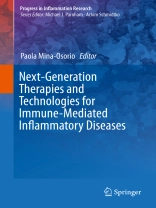As our understanding of immune mediated chronic inflammatory diseases (IMIDs) grows, it becomes more and more clear that these conditions result from the convergence of a multitude of pathogenic mechanisms whose relative individual contribution is different in different patient subsets.
Promising new technologies have been conceived that address the hypotheses that targeting multiple pathways simultaneously, selectively delivering therapeutics to areas of inflammation and/or resetting the immune system, could take efficacy to new levels. However, we have long waited for the arrival of some of these technologies to the bedside, or even far enough in the drug development process in spite of the initial enthusiasm. Some of the examples covered in this book include bispecific antibodies and genomic medicines, microparticles and targeted delivery of drugs to inflamed vasculature.
Most published reviews and book chapters on novel therapies for inflammatory diseases describe positive attributes of molecules or technologies under investigation and the rationale for developing them into therapeutics. The originality and potential value of this book is not in the description of these targets or technologies from the point of view of their structure or mechanism of action exclusively, but rather, in making an effort to critically address the question of what is needed to move these technologies into the clinic. Has the technology not made it past the preclinical stage and why? Has it already been tested in humans and failed? What are the potential reasons behind those failures? What do experts in each field believe can be done better to increase the probabilities of success?
In addition, the authors address the competitive landscape and summarize clinical studies that have failed in the respective area. They talk about the patient populations that would be required for the successful conduction of a clinical trial to test certain molecules, and they proactively share their views regarding both the potential and the drawbacks of targets or methodologies.
Tabella dei contenuti
Preface.- Targeted drug delivery.- I. Bispecific antibodies.- II. Targeting neovessels with NGR peptides.- Genomic-based drugs.- III. Micro-RNA/aptamers.- Nanomedicine.- IV. Exosomes.- V. Microparticles.- Cross-functional targets.- VI. Metabolic targets in inflammation.- VII. Targeting gut microbiome-immune system interactions.- VIII. Targeting the nervous system as an add on therapy for autoinflammatory conditions.- Biomarkers.- IX. Biomarkers in drug discovery.- Other therapies.- X. Stem cell therapy in the treatment of rheumatic disease and application in the treatment of systemic lupus erythematosus.
Circa l’autore
Paola Mina-Osorio MD., Ph D. has extensive experience in basic research and drug development in Inflammation/Immunology both in academia and in the pharmaceutical industry. She has had prominent roles in several programs in rheumatoid arthritis, psoriatic arthritis, psoriasis and lupus, including small molecule and biologic drug candidates. At the time of this submission she was a Medical Advisor at the Dermatology and Inflammation department at Eli Lilly & Company. She is currently Medical Director, Immunology Medical Affairs at Regeneron Pharmaceuticals, Inc. in Tarrytown, NY, USA .












